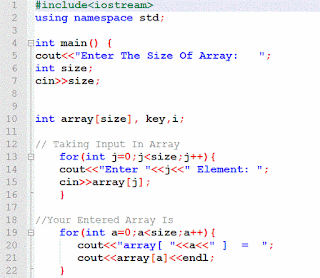PROGRAMMING
WHAT IS PROGRAMMING?
Programming is the use of codes to create different programs or tasks that the computer can do. There are many different types of coding languages to use while programming. For example Java, C++, and Python. Programming is usually a procedure that takes in input data, processes it and turns it in to output data.
Python Programming
Many major companies like Disney, IBM and NASA use Python to code. Python has been used to create many different video games and other general purpose tasks. Python is a coding language that allows the user to do the same tasks as Java and C++, but in a fewer amount of lines.
Java Programming
The Java code first appeared in 1995. The code is is much simpler than C++, and allows the programs to be used on one computer or over a server, which allows many people to access the program. The Java code is specially designed for Object-Oriented Programming. Object-Oriented Programming is a way to manipulate objects and data rather than the actions.
C++ Programming
C++ programming is used for packaged software most of the time. This includes games, Office applications, graphic and video editors, and operating systems. Most software that is not used online was most likely created by the C++ coding language.
Different Fields That Programming Is Used In
Programming is a wonderful asset to have and will make you stand out while looking for jobs. Almost all companies use some type of program, so knowing how to code will make you look like a prime candidate. Programming is used in Biology, Physics, Finance, Math, Robotics, and Graphic Design.
History of Programming
The first programmer was Ada Lovelace. In 1842-1843 she worked on translating an article about Charles Babbage's analytic engine. They found an algorithm in her notes, which makes her the first programmer. Ada Lovelace also predicted that computers would be able to play music and chess in the future. There is a programming language named after her that the US Department of Defense uses.
In 1889, a man named Herman Hollerith created a machine that could read data. He invented the tabulator and keypunch machines that were the basis for information processing. He created a company called The Tabulating Machine Company in 1892, which is now IBM. The first electronic and digital computer was created by Herman Hollerith. It was called the Atanasoff-Berry Computer and was used to solve linear equations.

The first electronic digital programmable computers were the Colossus computers which were developed during World War II, and were created to decipher German messages.
Fortran was the first advanced level of programming language used. It was created by John Backus, who worked for IBM. It was created in 1954 and released to the public in 1957.
The first computer game was called Spacewar. It took nearly 200 hours for Steve Russell to create the game, which allows two players to fire missiles at each other. He worked with Nolan Bushnell at Stanford and created the first coin operated arcade game.
Fred Cohen designed the first virus for computers. He used a floppy disc that could be inserted into the computer, copy itself and then spread to other computers. It was only designed to see if it would work. There was no harm that the virus caused.

























